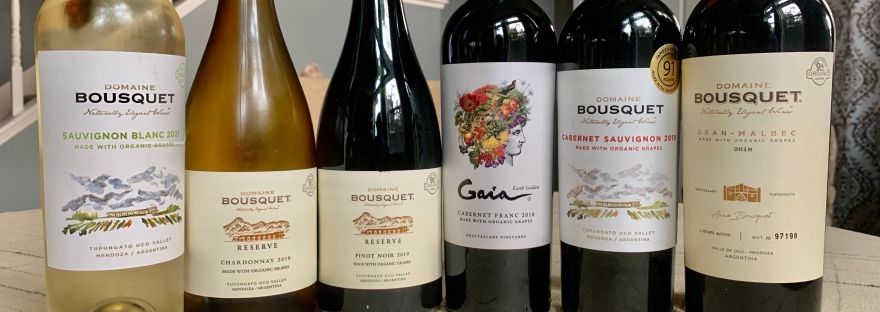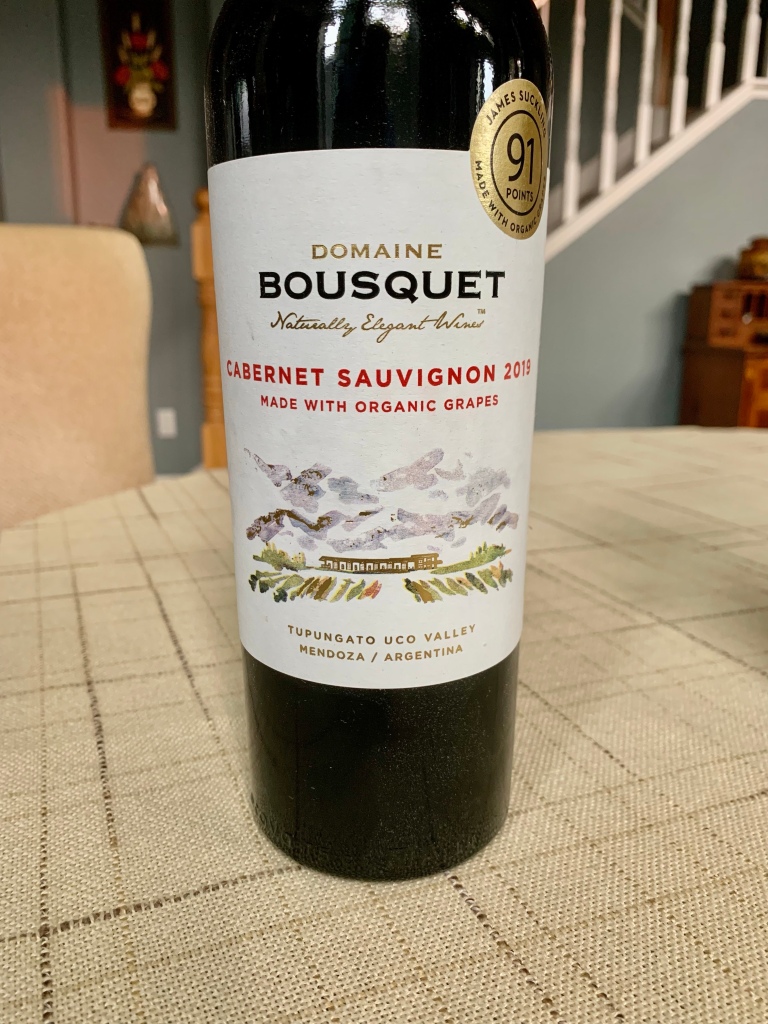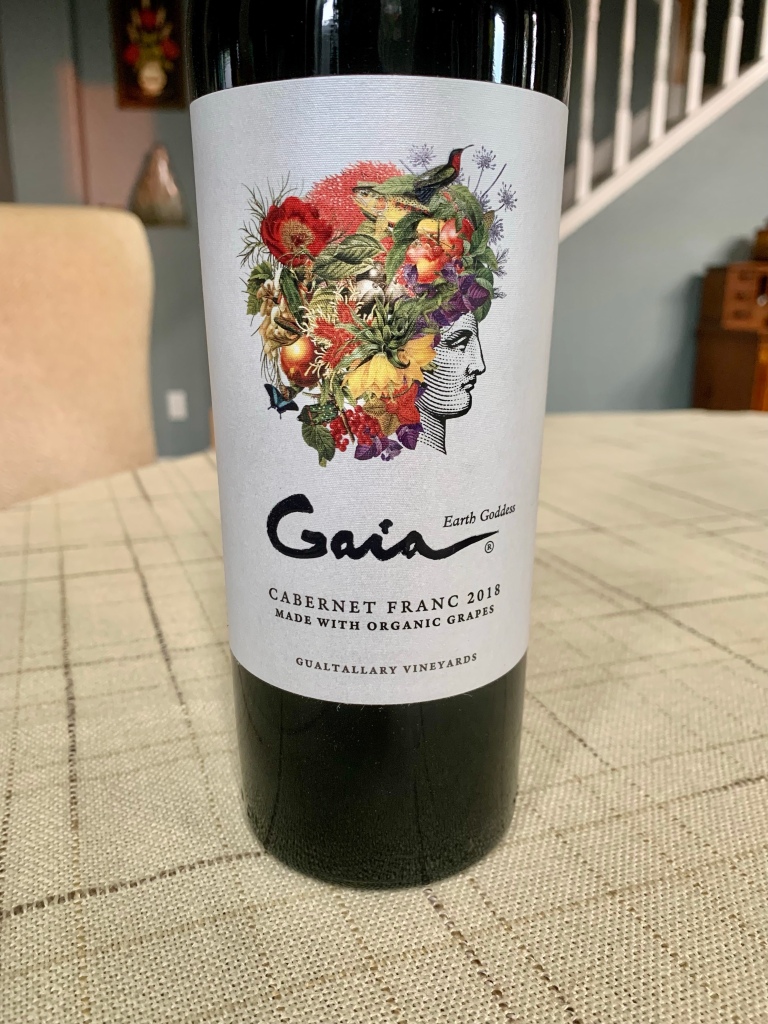We wrote about Domaine Bousquet not long ago, when we received a sample of their Gaia Rosé 2020. In that post, we wrote a little about the history of the Bousquet family and the creation of Domaine Bousquet in the Gualtallary Valley, high in the mountains in Argentina, and the fantastic wine. So naturally, we were honored when we were invited to a virtual tasting including discussions with Anne Bousquet, current proprietor of the winery, and Franco Bastias, the winery’s chief agronomist. (What’s an agronomist? An expert in the science of soil management and crop production. Now you know, too.) Of course, to be a virtual “tasting”, one must have wines to taste. We were pleased to receive as samples, six bottles of Domaine Bousquet wine.
The following wines were provided as media samples for review. All reviews, descriptions, and opinions are our own. We received no additional compensation.
In their presentation, entitled “Dishing the Dirt”, Anne and Franco discussed what makes the terroir of Domaine Bousquet so unique. Spoiler alert: The subtitle is “The secret is in the soil.” Anne started us off with some history of the land, family, and winery.
In 1997, Anne’s father Jean Bousquet, moved from Carcassonne, in Languedoc, France, to the Gualtallary Valley, and purchased a plot of land that had never been cultivated. In this arid region, the driest wine growing region in the world, first things must come first, so in 1998, Jean Bousquet dug a 495 foot deep well for irrigation. Meanwhile, in 2002 as vineyards were taking shape, Anne and her husband, Labid Al Ameri, started to invest in the winery, while maintaining their non-wine-industry careers in Boston. The first vintage was released in 2005, and Labid joined full time in the sales department. By 2008, Anne was on board and she and her family relocated to Argentina. Jean retired in 2011, and Anne and Labid, and Anne’s brother, bought Domain Bousquet and assumed day to day operations. In the years since, production has increased, and in 2020, they sold approximately 7 million bottles of wine.
Domaine Bousquet is planted to 618 acres of vines, all of which are organic. In fact, they received their organic certification in 2005, the same year as their first vintage was released. With Domaine Bousquet coming out of the gate as certified organic, they raised the bar for other growers in the region, from whom Domaine Bousquet would buy grapes, and many of them have achieved organic certification as well. In addition to organic, Domaine Bousquet has also achieved certifications as vegan and sustainable.
As good as organic, vegan, and sustainable is, Domaine Bousquet doesn’t stop there. They have launched a “360° Sustainability Commitment”. This includes supporting the community and the people who live in and around the town. This is a three-prong commitment: environmental, social, and economic. We’ve covered the environmental part. On the social and economic sides, Domaine Bousquet is certified “Fair for Life.” This certification is part of a fair trade and corporate responsibility commitment for global change for the better and helping others. As part of this, the winery supports several children’s homes in the area, and has donated more than $113,000 to help those in the community experiencing economic hardship and social exclusion. Those are some causes we can get behind and gladly support by purchasing Domaine Bousquet wines!
Next, we met Franco. Franco’s energy and enthusiasm were immediately evident, and infectious. He gave us some geography lessons, then, in video segments, took us deep into the soil. Literally.
The Uco Valley is comprised of three departments: Tupungato in the north, Tunuyan in the middle, and San Carlos in the south. Domaine Bousquet is located in Tupungato. This area of the valley was originally settled by Jesuit missionaries in the 17th century. By the early 1900’s, orchards, vineyards, and other crops were planted. It wasn’t until the early 2000’s, however, that the wine world started to take notice, as local producers started attracting attention to the region.
The soils in Tupungato vary from rocky to sandy and silt, which flowed down from the Andes mountains. At these elevations, and with the harsh winters there, diurnal temperature swings of up to 59°F can occur, resulting in fresh, fruity wines. One of the other distinctive conditions are calcareous soils, containing concentrations of calcium deposits, which add to the unique character of the wines.
In the video segments, Franco showed us cross sections of the soil conditions in soil pits, which are dug several feet deep directly adjacent to rows of vines. This was fascinating to see, as each of the wines featured have different soil conditions. As Franco walked us through the various soil pits, we tasted along with the wines. Isn’t that what it’s all about?
Domaine Bousquet Sauvignon Blanc 2021
Pale straw color. On the nose, apricot, peach, and pineapple. On the palate, pineapple, citrus, peach, and pear. Bracing acidity, yet very smooth with a soft finish.
Domaine Bousquet Reserve Chardonnay 2019
A very unique and enjoyable Chardonnay. Golden color. Nose of pear, peach, and tropical fruit /mango. On the palate, a tropical paradise: pineapple, mango, with citrus, pear, and just a hint of butter. Creamy mouthfeel, with balanced, vibrant acidity. Medium plus body, with a citrus finish.
Domaine Bousquet Reserve Pinot Noir 2019
Bright ruby color. Cherry, raspberry preserves, and white pepper on the nose. On the palate, juicy fruit flavors of raspberry, strawberry, and red cherry, with cedar, and spice. Light-to-medium body, soft tannins, bright acidity, and a medium red fruit finish.
Domaine Bousquet Cabernet Sauvignon 2019
Deep garnet color with a ruby rim. Lots of classic Cab Sauv characteristics. Nose of blackberry, cassis, and black cherry. On the palate, black cherry, plum, black currant, blackberry, and cedar. Medium-plus body, integrated tannins, medium acidity, and a long finish of red fruit, baking spice, and pepper. Fresh & clean so the fruit really shines.
Domaine Bousquet Gaia Cabernet Franc 2018
Inky garnet color. Funky, earthy nose, with red cherry and boysenberry. On the palate, ripe, juicy blackberry, boysenberry, blueberry, and hints of bell pepper and baking spice. Big, full body, with ripe tannins, medium acidity, and a long finish of dark fruit and black pepper and minerals.
Domaine Bousquet Gran Malbec 2018
Wow! Very soft and smooth. Deep purple with a garnet rim. Black cherry, plum, and blackberry on the nose. On the palate, ripe blackberry, black cherry, blueberry, and Marionberry, with hints of cedar, cocoa, and baking spice. Rich, full body with velvety tannins, medium acidity, and a long finish of black fruit and chocolate.
All of the wines are very well structured and balanced. With minimal oak influence, each wine allows the fruit to take center stage and shine. In the days following the virtual tasting, we enjoyed finishing the bottles with our meals. All are very food friendly, yet able to stand on their own as evening sippers. Did we mention value? The SRP for these wines is shocking; they all drink well above their price point!
- Domaine Bousquet Sauvignon Blanc 2021 / SRP $13
- Domaine Bousquet Reserve Chardonnay 2019 / SRP $18
- Domaine Bousquet Reserve Pinot Noir 2019 / SRP $18
- Domaine Bousquet Cabernet Sauvignon 2019 / SRP $13
- Domaine Bousquet Gaia Cabernet Franc 2018 / SRP $20
- Domaine Bousquet Gran Malbec 2018 / SRP $25
We are very impressed with the wines that Domaine Bousquet is producing, and their commitment to sustainability and corporate social responsibility. We definitely recommend you seek out these wines and enjoy them for yourself.
Cheers!
- By Kent Reynolds and Robyn Raphael-Reynolds
- Photos by Kent Reynolds






























